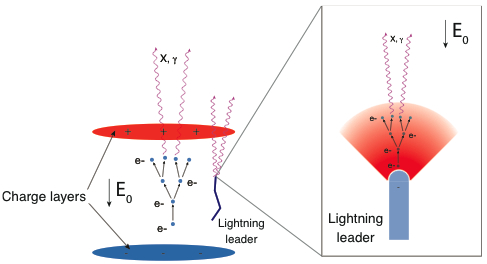Terrestrial gamma-ray flashes
Terrestrial gamma-ray flashes (TGFs) are high-energy photons originating from the Earth's atmosphere in association with thunderstorm activity. TGFs were serendipitously discovered by BATSE detectors aboard the Compton Gamma-Ray Observatory. TGFs have also been detected and further studied by the RHESSI, AGILE and Fermi satellites. Their emission extends up to 100 MeV and exhibits an e+ – e- annihilation line. TGFs were utterly unexpected and as of now they are not fully understood. They are believed to be the product of particles acceleration inside thunderstorms. As they are produced in the Earth’s atmosphere, they potentially have a tremendous impact on our understanding of thunderstorms and atmospheric electrodynamics in general.
Required instrument performances:
TGFs have peculiar characteristics due to their specific production mechanisms in the atmosphere (the low energy spectral cutoff) and the proximity of their sources to the detectors (a few hundreds of kilometers). Recent results by Fermi-GBM show that they are very short (50 – 500 microseconds) and usually so intense that effects of detector deadtime and pile-up are issues to be avoided. Their position being unpredictable, a large field of view (> 90°) is required and very good localization capabilities will help correlate them with other simultaneous phenomena in thunderstorms. Detection and identification of relativistic electrons associated with TGFs are of great importance.

Illustration of two theories that may explain TGFs. Left: a relativistic runaway electron avalanche in the thunderstorm weak electric field (e.g., Dwyer 2008, JGR 113, D10103). Right: thermal runaway electrons in the lightning leader field (e.g., Celestin & Pasko 2011, JGR 116, A03315). Credit: S. Celestin
|
Required instrument performances:
TGFs have peculiar characteristics due to their specific production mechanisms in the atmosphere (the low energy spectral cutoff) and the proximity of their sources to the detectors (a few hundreds of kilometers). Recent results by Fermi-GBM show that they are very short (50 – 500 microseconds) and usually so intense that effects of detector deadtime and pile-up are issues to be avoided. Their position being unpredictable, a large field of view (> 90°) is required and very good localization capabilities will help correlate them with other simultaneous phenomena in thunderstorms. Detection and identification of relativistic electrons associated with TGFs are of great importance.
| Performance parameter | Goal value | Remarks and notes |
|
Field-of-view (FWHM, deg) |
~ 90° | Pointed towards Earth |
|
Angular resolution (FWHM, deg) |
~ 0.05° – 0.1° | 0.05° corresponds to a distance of ~1 km at the source location as seen from a low Earth orbit |
|
Spectral resolution (ΔE/E @ Energy) |
10% | |
|
Line sensitivity (@ Energy) (cm-2 s-1, 3σ, 1 Ms) |
- | |
|
Continuum sensitivity (in which energy band?) (cm-2 s-1 keV-1, ΔE=E, 3σ, 1 Ms) |
Not restrictive |
0.01 – 100 MeV range |
| Timing performances | Dead time < 1 microsec | Total duration is typically 50 – 500 microsec |
|
Polarimetric capability (Minimum Polarization Fraction for a Crab source in 1 Ms) |
- |
|
| Real-time data? | no |
 AstroMeV
AstroMeV